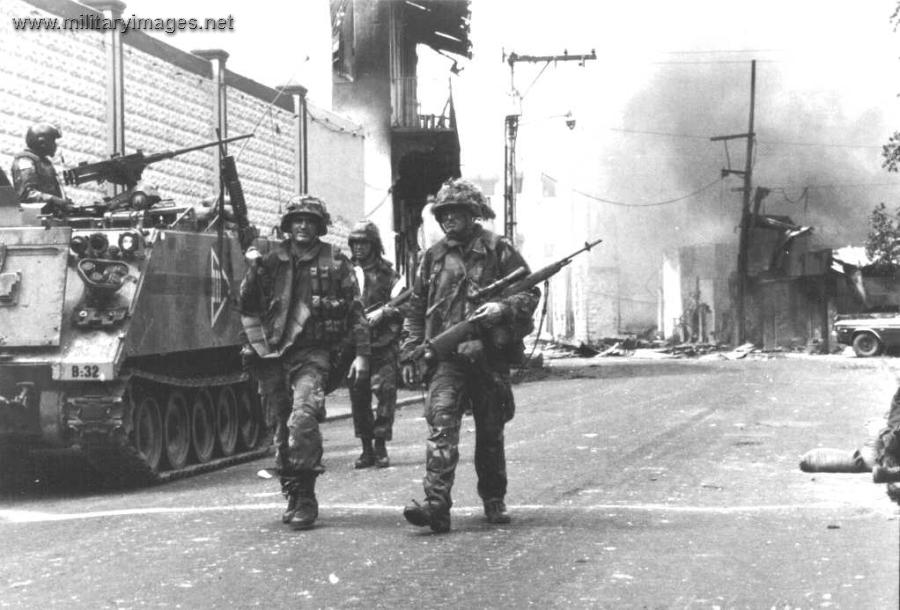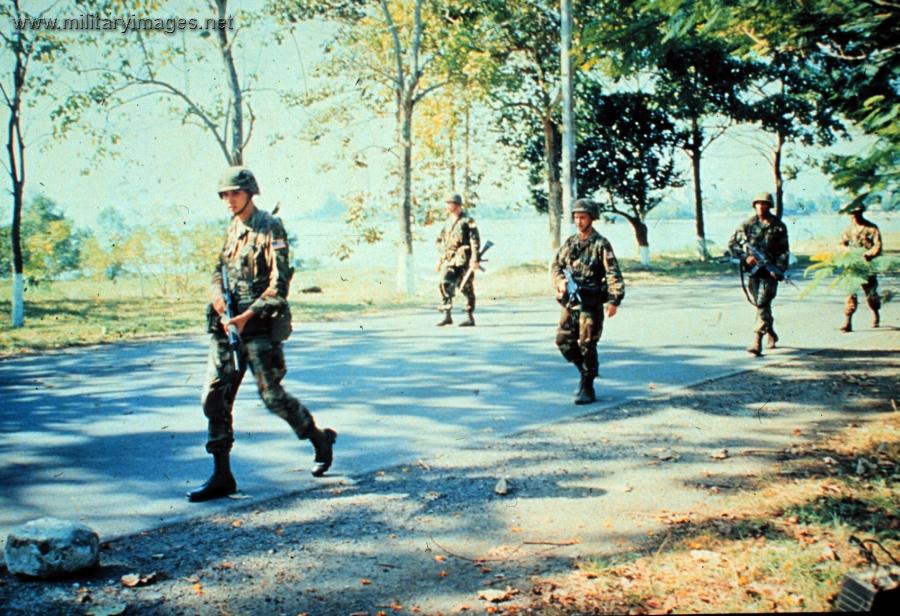- Joined
- Apr 2, 2017
- Messages
- 38,439
- Points
- 463
The United States Invasion of Panama, codenamed Operation Just Cause, lasted over a month between mid-December 1989 and late January 1990. It occurred during the administration of President George H. W. Bush and ten years after the Torrijos–Carter Treaties were ratified to transfer control of the Panama Canal from the U.S. to Panama by 1 January 2000. During the invasion, de facto Panamanian leader, general, and dictator Manuel Noriega, who for a long time worked with the Central Intelligence Agency, was deposed citing racketeering and drug trafficking. Following the operation, the Panama Defense Forces was dissolved and President-elect Guillermo Endara was sworn into office.
In May 1989, during the Panamanian national elections, an alliance of parties opposed to the Noriega dictatorship counted results from the country's election precincts, before they were sent to the district centres. Their tally showed their candidate, Guillermo Endara, defeating Carlos Duque, candidate of a pro-Noriega coalition, by nearly 3–1. Endara was physically assaulted by Noriega supporters the next day in his motorcade. Noriega declared the election null and maintained power by force, making him unpopular among Panamanians. Noriega's government insisted that it had won the presidential election and that irregularities had been on the part of U.S.-backed candidates from opposition parties. Bush called on Noriega to honor the will of the Panamanian people. The United States reinforced its Canal Zone garrison, and increased the tempo of training and other activities intended to put pressure on Noriega.
In October 1989, Noriega foiled a second coup attempt by members of the Panamanian Defense Forces (PDF), led by Major Moisés Giroldi. Pressure mounted on Bush. Bush declared that the U.S. would not negotiate with a drug trafficker and denied knowledge of Noriega's involvement with the drug trade prior to his February 1988 indictment, although Bush had met with Noriega while Director of the CIA and had been the Chair of the Task Force on Drugs while Vice President. On 15 December, the Panamanian general assembly passed a resolution declaring that a state of war existed between Panama and the United States
The next day, four U.S. military personnel were stopped at a roadblock around 9:00 p.m. outside PDF headquarters in the El Chorrillo neighborhood of Panama City. Marine Captain Richard E. Hadded, Navy Lieutenant Michael J. Wilson, Army Captain Barry L. Rainwater, and Marine First Lieutenant Robert Paz had left the Fort Clayton military base and were on their way to have dinner at the Marriott Hotel in downtown Panama City. The U.S. Department of Defense reported that the servicemen had been unarmed, were in a private vehicle, and attempted to flee only after their vehicle was surrounded by an angry crowd of civilians and PDF troops. The PDF asserted later that the Americans were armed and on a reconnaissance mission. The PDF opened fire and Lieutenant Paz was fatally wounded by a round that entered the rear of the vehicle and struck him in the back. Captain Hadded, the driver of the vehicle, was also wounded in the foot. Paz was rushed to Gorgas Army Hospital but died of his wounds. He received the Purple Heart posthumously. According to U.S. military sources, a U.S. Naval officer and his wife witnessed the incident and were detained by Panamanian Defense Force soldiers. While in police custody, they were assaulted by the PDF. The U.S. Naval officer spent two weeks in hospital recovering from the beating. PDF soldiers sexually threatened his wife. The next day, President Bush ordered the execution of the Panama invasion plan; the military set H-Hour as 0100 on 20 December
In May 1989, during the Panamanian national elections, an alliance of parties opposed to the Noriega dictatorship counted results from the country's election precincts, before they were sent to the district centres. Their tally showed their candidate, Guillermo Endara, defeating Carlos Duque, candidate of a pro-Noriega coalition, by nearly 3–1. Endara was physically assaulted by Noriega supporters the next day in his motorcade. Noriega declared the election null and maintained power by force, making him unpopular among Panamanians. Noriega's government insisted that it had won the presidential election and that irregularities had been on the part of U.S.-backed candidates from opposition parties. Bush called on Noriega to honor the will of the Panamanian people. The United States reinforced its Canal Zone garrison, and increased the tempo of training and other activities intended to put pressure on Noriega.
In October 1989, Noriega foiled a second coup attempt by members of the Panamanian Defense Forces (PDF), led by Major Moisés Giroldi. Pressure mounted on Bush. Bush declared that the U.S. would not negotiate with a drug trafficker and denied knowledge of Noriega's involvement with the drug trade prior to his February 1988 indictment, although Bush had met with Noriega while Director of the CIA and had been the Chair of the Task Force on Drugs while Vice President. On 15 December, the Panamanian general assembly passed a resolution declaring that a state of war existed between Panama and the United States
The next day, four U.S. military personnel were stopped at a roadblock around 9:00 p.m. outside PDF headquarters in the El Chorrillo neighborhood of Panama City. Marine Captain Richard E. Hadded, Navy Lieutenant Michael J. Wilson, Army Captain Barry L. Rainwater, and Marine First Lieutenant Robert Paz had left the Fort Clayton military base and were on their way to have dinner at the Marriott Hotel in downtown Panama City. The U.S. Department of Defense reported that the servicemen had been unarmed, were in a private vehicle, and attempted to flee only after their vehicle was surrounded by an angry crowd of civilians and PDF troops. The PDF asserted later that the Americans were armed and on a reconnaissance mission. The PDF opened fire and Lieutenant Paz was fatally wounded by a round that entered the rear of the vehicle and struck him in the back. Captain Hadded, the driver of the vehicle, was also wounded in the foot. Paz was rushed to Gorgas Army Hospital but died of his wounds. He received the Purple Heart posthumously. According to U.S. military sources, a U.S. Naval officer and his wife witnessed the incident and were detained by Panamanian Defense Force soldiers. While in police custody, they were assaulted by the PDF. The U.S. Naval officer spent two weeks in hospital recovering from the beating. PDF soldiers sexually threatened his wife. The next day, President Bush ordered the execution of the Panama invasion plan; the military set H-Hour as 0100 on 20 December

















